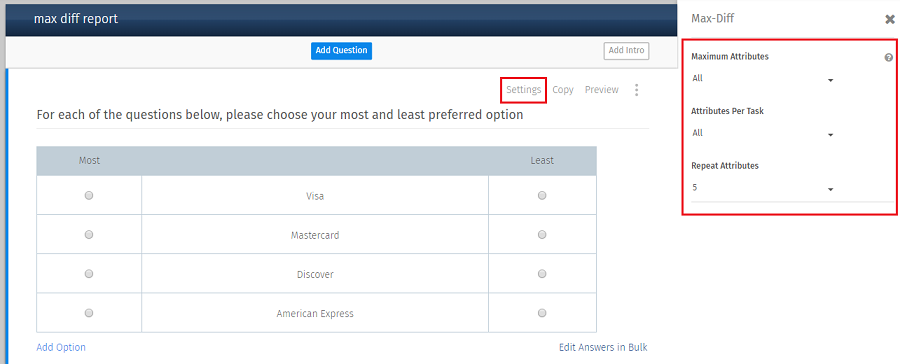
Max Diff Settings
MaxDiff is a methodology developed by Jordan Louviere et al., that results in interval scale measurements that are based on comparative judgments that can be easily performed, even when the number of attributes is not small. The task presents respondents with a set of items, usually 3 to 6, and simply asks them to select the most preferred and the least preferred in the set (or the most important, least important; best item, worst item, etc. In fact the method is also referred to as Best/Worst scaling). Respondents can typically handle a number of these evaluations, and may be asked to respond to 15, 20, or more sets.
Maximum Difference Scaling is a very effective method of establishing the relative priority attached by an audience to a large set of items (up to 30). These items might be:
- Features or benefits of a service
- Areas for potential investment of resources
- Interests and activities
- Potential marketing messages for a new product
- Products or Services used
Traditionally, for a large number of items (more than 10) this might have been addressed via a rating scale. For example, we might ask on a numeric scale of 1..10 where 1 is not important at all and 10 is Extremely important, how important is each item? Each item's average score can then be presented for any subgroup.
 Maximum Attributes: Out of the Attributes listed in the question we have the option to choose or limit the attributes to be displayed according to the task.
Maximum Attributes: Out of the Attributes listed in the question we have the option to choose or limit the attributes to be displayed according to the task.
For Example: When there are 9 attributes you can limit it to 6, so that only 6 will be displayed.
Attributes Per Task: Out of selected maximum attribute we can select how many attributes we want to show per task.
For Example: If maximum attributes are 4, you can set the attributes per task as 2. So it will show 2 attributes per task.
Repeat Attributes: When you want to repeat a set of attributes, this function is used.
For Example: There are 6 attributes listed in the question and if you want to repeat these attributes 4 times than each attribute will be shown 4 times to the respondent.
Example 1:
If All is selected in Maximum Attributes, and 1 is Selected in Repeat Attributes then each respondent will see all the attributes exactly one time.
Example 2:
If All is selected in Maximum Attributes, and 2 is Selected in Repeat Attributes then each respondent will see all the attributes exactly 2 times.
Example 3:
If 3 is selected in Maximum Attributes, and 2 is Selected in Repeat Attributes then each respondent will see 3 of the attributes exactly 2 times and will never see the remaining one.

